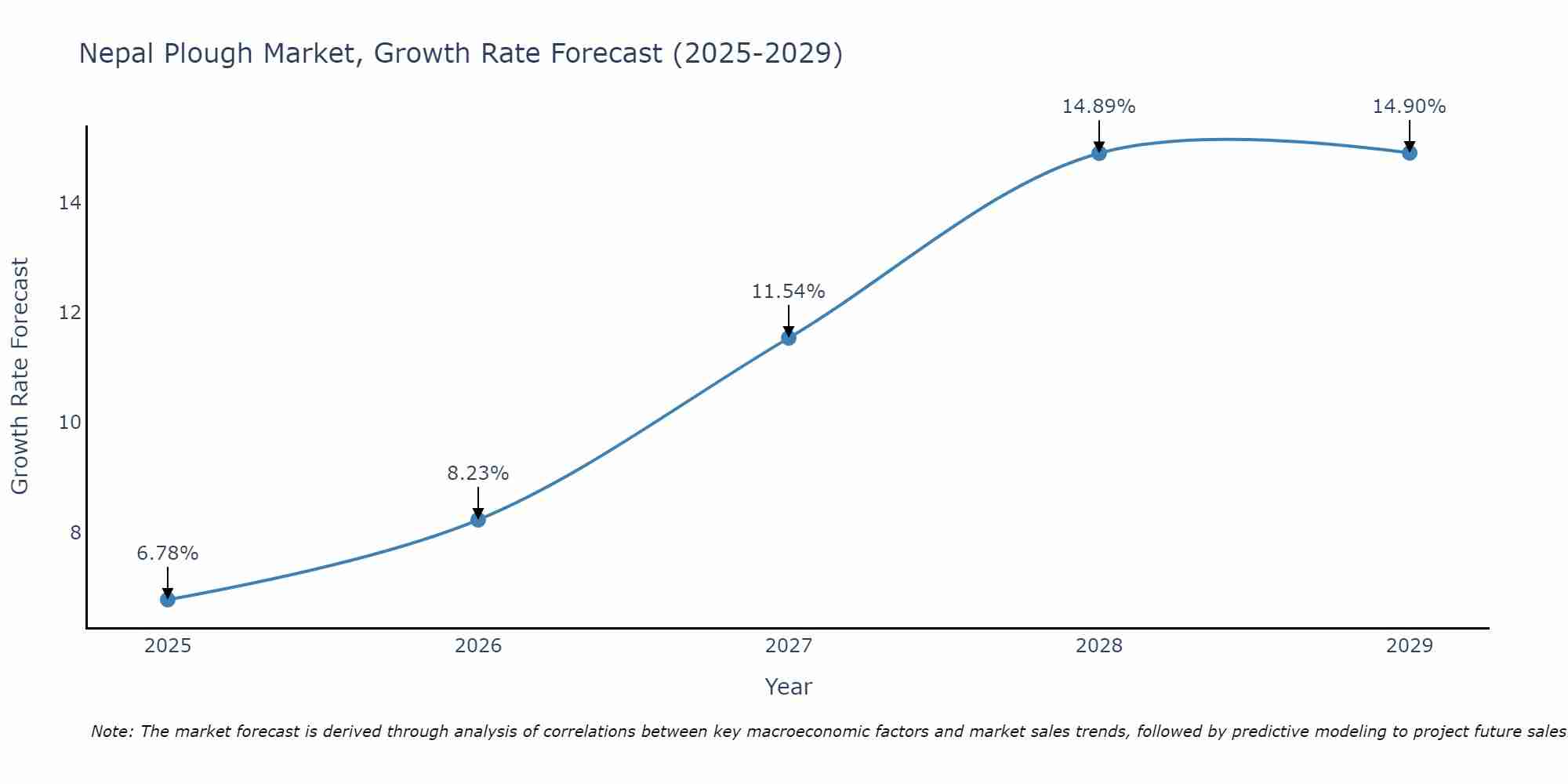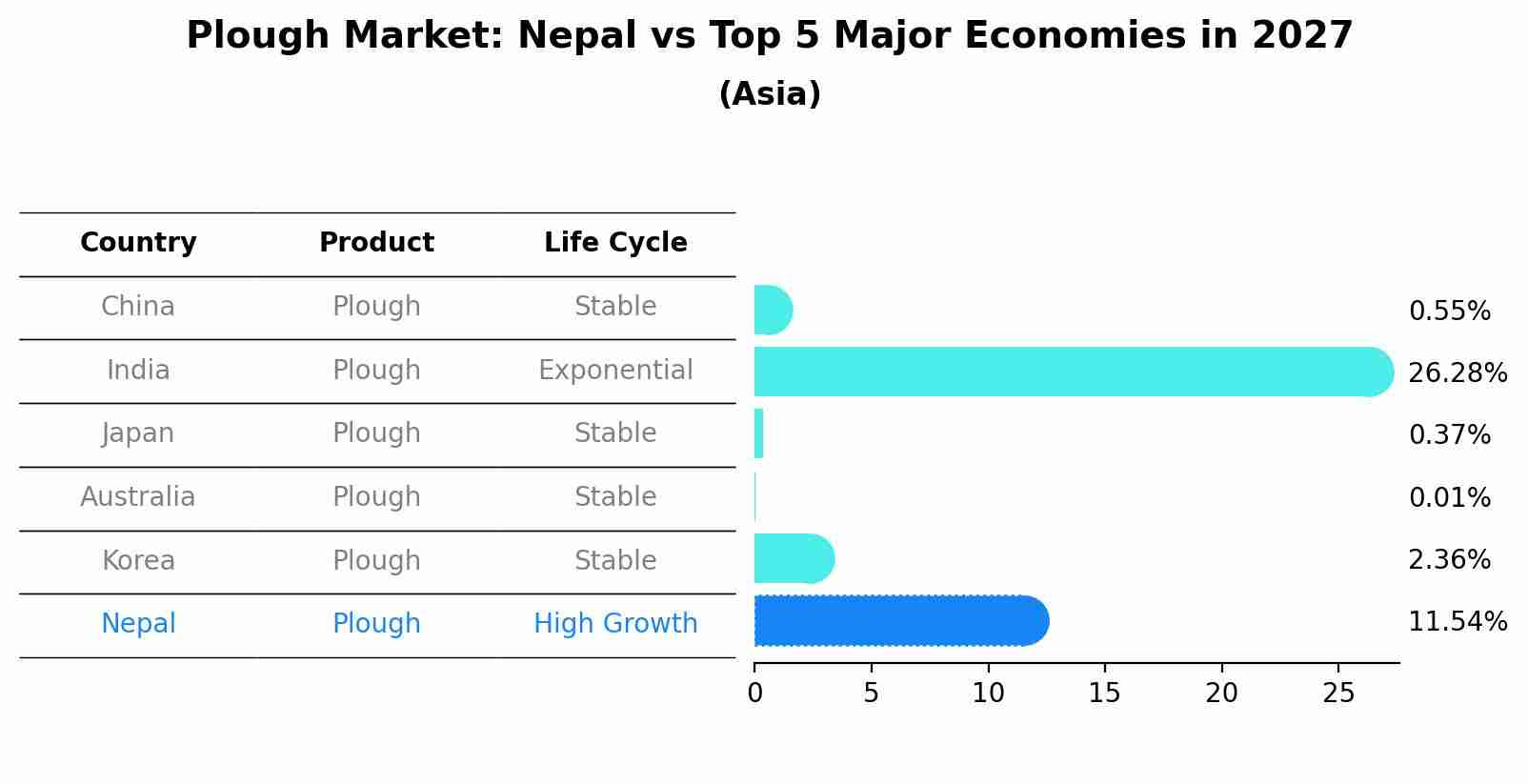Nepal Plough Market (2025-2031) | Value, Size, Forecast, Trends, Companies, Growth, Revenue, Share, Analysis, Industry & Outlook
| Product Code: ETC051496 | Publication Date: Jan 2021 | Updated Date: Jun 2025 | Product Type: Report | |
| Publisher: 6Wresearch | Author: Summon Dutta | No. of Pages: 70 | No. of Figures: 35 | No. of Tables: 5 |
Nepal Plough Market Size Growth Rate
The Nepal Plough Market is likely to experience consistent growth rate gains over the period 2025 to 2029. The growth rate starts at 6.78% in 2025 and reaches 14.90% by 2029.

Plough Market: Nepal vs Top 5 Major Economies in 2027 (Asia)
By 2027, Nepal's Plough market is forecasted to achieve a high growth rate of 11.54%, with China leading the Asia region, followed by India, Japan, Australia and South Korea.

Nepal Plough Market Overview
The Nepal plough market is primarily driven by the country`s heavy reliance on agriculture as a significant economic activity. The market offers a variety of plough types, including traditional wooden ploughs and modern steel ploughs, catering to the diverse needs of local farmers. Factors such as government initiatives to promote mechanized farming, increasing adoption of modern agricultural practices, and rising demand for higher productivity have contributed to the growth of the plough market in Nepal. Key market players focus on product innovation, quality improvement, and affordability to stay competitive. Additionally, the market is influenced by seasonal fluctuations and changing weather patterns, impacting the demand for ploughs. Overall, the Nepal plough market presents opportunities for manufacturers to expand their product offerings and establish a strong presence in the evolving agricultural sector.
Nepal Plough Market Trends
Currently in the Nepal plough market, there is a noticeable shift towards more sustainable and eco-friendly ploughing practices. Farmers are increasingly looking for ploughs that are efficient in terms of fuel consumption and soil conservation. Traditional ploughs are being replaced by modern equipment that are more mechanized and easy to operate. Additionally, there is a growing demand for ploughs that can be used for multiple purposes, such as seeding and weeding. Manufacturers are focusing on developing innovative plough designs that are adaptable to different types of soil and terrain. Overall, the trend in the Nepal plough market is towards more efficient, versatile, and environmentally friendly equipment to meet the evolving needs of farmers in the region.
Nepal Plough Market Challenges
In the Nepal plough market, there are several challenges faced by both buyers and sellers. One major challenge is the lack of access to modern technology and machinery, leading to inefficiencies in the production process and higher costs. Additionally, the market may be fragmented with numerous small suppliers, making it difficult for buyers to find reliable and consistent sources of ploughs. Quality control and standardization can also be issues, as there may be variations in the manufacturing processes and materials used by different suppliers. Furthermore, limited financial resources and infrastructure constraints in certain regions of Nepal can hinder the distribution and availability of ploughs in the market. Overall, addressing these challenges through improved technology adoption, supply chain management, and quality control measures can help boost the Nepal plough market.
Nepal Plough Market Investment Opportunities
In the Nepal Plough market, there are several investment opportunities that could be promising. One potential opportunity lies in the modernization and mechanization of traditional ploughing methods. Investing in innovative plough designs, machinery, and technology could significantly improve efficiency and productivity for farmers in Nepal. Additionally, there is a growing demand for sustainable and eco-friendly ploughing solutions, presenting an opportunity for investments in environmentally conscious ploughing equipment. Furthermore, investing in research and development to create customized ploughing solutions for Nepal`s diverse agricultural landscape could also be a lucrative opportunity. Overall, the Nepal Plough market offers potential for investors to contribute to the modernization and improvement of agricultural practices in the country while also generating profitable returns.
Nepal Plough Market Government Policy
The Nepal government has implemented policies to regulate the plough market in the country. These policies aim to promote fair competition, ensure quality standards, and protect the interests of both consumers and producers. The government has set guidelines for pricing, distribution, and marketing practices within the plough market to prevent monopolies and price manipulation. Additionally, there are regulations in place to monitor the quality of ploughs being sold and to enforce safety standards to protect users. The government also provides support and incentives to encourage innovation and technological advancements in the plough industry. Overall, the government`s policies in the Nepal plough market are designed to foster a competitive and sustainable market environment while safeguarding the welfare of all stakeholders involved.
Nepal Plough Market Future Outlook
The future outlook for the Nepal Plough Market appears positive, driven by increasing adoption of modern agricultural practices and the government`s initiatives to promote mechanization in farming. With the growing emphasis on improving agricultural productivity and efficiency, there is a rising demand for advanced ploughing equipment among farmers. Additionally, the availability of subsidies and financial assistance for farmers investing in agricultural machinery is expected to further boost market growth. Technological advancements such as GPS integration and automation in ploughing equipment are also anticipated to drive market expansion in the coming years. Overall, the Nepal Plough Market is poised for steady growth as the agriculture sector continues to modernize and adapt to meet the increasing food demand of a growing population.
Key Highlights of the Report:
- Nepal Plough Market Outlook
- Market Size of Nepal Plough Market, 2024
- Forecast of Nepal Plough Market, 2031
- Historical Data and Forecast of Nepal Plough Revenues & Volume for the Period 2021 - 2031
- Nepal Plough Market Trend Evolution
- Nepal Plough Market Drivers and Challenges
- Nepal Plough Price Trends
- Nepal Plough Porter's Five Forces
- Nepal Plough Industry Life Cycle
- Historical Data and Forecast of Nepal Plough Market Revenues & Volume By Types for the Period 2021 - 2031
- Historical Data and Forecast of Nepal Plough Market Revenues & Volume By Traditional Plough for the Period 2021 - 2031
- Historical Data and Forecast of Nepal Plough Market Revenues & Volume By Modern Plough for the Period 2021 - 2031
- Historical Data and Forecast of Nepal Plough Market Revenues & Volume By Specialist Plough for the Period 2021 - 2031
- Historical Data and Forecast of Nepal Plough Market Revenues & Volume By Application for the Period 2021 - 2031
- Historical Data and Forecast of Nepal Plough Market Revenues & Volume By Farm for the Period 2021 - 2031
- Historical Data and Forecast of Nepal Plough Market Revenues & Volume By Individual Farming for the Period 2021 - 2031
- Nepal Plough Import Export Trade Statistics
- Market Opportunity Assessment By Types
- Market Opportunity Assessment By Application
- Nepal Plough Top Companies Market Share
- Nepal Plough Competitive Benchmarking By Technical and Operational Parameters
- Nepal Plough Company Profiles
- Nepal Plough Key Strategic Recommendations
Frequently Asked Questions About the Market Study (FAQs):
1 Executive Summary |
2 Introduction |
2.1 Key Highlights of the Report |
2.2 Report Description |
2.3 Market Scope & Segmentation |
2.4 Research Methodology |
2.5 Assumptions |
3 Nepal Plough Market Overview |
3.1 Nepal Country Macro Economic Indicators |
3.2 Nepal Plough Market Revenues & Volume, 2024 & 2031F |
3.3 Nepal Plough Market - Industry Life Cycle |
3.4 Nepal Plough Market - Porter's Five Forces |
3.5 Nepal Plough Market Revenues & Volume Share, By Types, 2024 & 2031F |
3.6 Nepal Plough Market Revenues & Volume Share, By Application, 2024 & 2031F |
4 Nepal Plough Market Dynamics |
4.1 Impact Analysis |
4.2 Market Drivers |
4.3 Market Restraints |
5 Nepal Plough Market Trends |
6 Nepal Plough Market, By Types |
6.1 Nepal Plough Market, By Types |
6.1.1 Overview and Analysis |
6.1.2 Nepal Plough Market Revenues & Volume, By Types, 2016 - 2031F |
6.1.3 Nepal Plough Market Revenues & Volume, By Traditional Plough, 2016 - 2031F |
6.1.4 Nepal Plough Market Revenues & Volume, By Modern Plough, 2016 - 2031F |
6.1.5 Nepal Plough Market Revenues & Volume, By Specialist Plough, 2016 - 2031F |
6.2 Nepal Plough Market, By Application |
6.2.1 Overview and Analysis |
6.2.2 Nepal Plough Market Revenues & Volume, By Farm, 2016 - 2031F |
6.2.3 Nepal Plough Market Revenues & Volume, By Individual Farming, 2016 - 2031F |
7 Nepal Plough Market Import-Export Trade Statistics |
7.1 Nepal Plough Market Export to Major Countries |
7.2 Nepal Plough Market Imports from Major Countries |
8 Nepal Plough Market Key Performance Indicators |
9 Nepal Plough Market - Opportunity Assessment |
9.1 Nepal Plough Market Opportunity Assessment, By Types, 2024 & 2031F |
9.2 Nepal Plough Market Opportunity Assessment, By Application, 2024 & 2031F |
10 Nepal Plough Market - Competitive Landscape |
10.1 Nepal Plough Market Revenue Share, By Companies, 2024 |
10.2 Nepal Plough Market Competitive Benchmarking, By Operating and Technical Parameters |
11 Company Profiles |
12 Recommendations |
13 Disclaimer |
- Single User License$ 1,995
- Department License$ 2,400
- Site License$ 3,120
- Global License$ 3,795
Search
Thought Leadership and Analyst Meet
Our Clients
Related Reports
- Germany Breakfast Food Market (2026-2032) | Industry, Share, Growth, Size, Companies, Value, Analysis, Revenue, Trends, Forecast & Outlook
- Australia Briquette Market (2025-2031) | Growth, Size, Revenue, Forecast, Analysis, Trends, Value, Share, Industry & Companies
- Vietnam System Integrator Market (2025-2031) | Size, Companies, Analysis, Industry, Value, Forecast, Growth, Trends, Revenue & Share
- ASEAN and Thailand Brain Health Supplements Market (2025-2031) | Strategy, Consumer Insights, Analysis, Investment Trends, Opportunities, Growth, Size, Share, Industry, Revenue, Segments, Value, Segmentation, Supply, Forecast, Restraints, Outlook, Competition, Drivers, Trends, Demand, Pricing Analysis, Competitive, Strategic Insights, Companies, Challenges
- ASEAN Bearings Market (2025-2031) | Strategy, Consumer Insights, Analysis, Investment Trends, Opportunities, Growth, Size, Share, Industry, Revenue, Segments, Value, Segmentation, Supply, Forecast, Restraints, Outlook, Competition, Drivers, Trends, Demand, Pricing Analysis, Competitive, Strategic Insights, Companies, Challenges
- Europe Flooring Market (2025-2031) | Outlook, Share, Industry, Trends, Forecast, Companies, Revenue, Size, Analysis, Growth & Value
- Saudi Arabia Manlift Market (2025-2031) | Outlook, Size, Growth, Trends, Companies, Industry, Revenue, Value, Share, Forecast & Analysis
- Uganda Excavator, Crane, and Wheel Loaders Market (2025-2031) | Strategy, Consumer Insights, Analysis, Investment Trends, Opportunities, Growth, Size, Share, Industry, Revenue, Segments, Value, Segmentation, Supply, Forecast, Restraints, Outlook, Competition, Drivers, Trends, Demand, Pricing Analysis, Competitive, Strategic Insights, Companies, Challenges
- Rwanda Excavator, Crane, and Wheel Loaders Market (2025-2031) | Strategy, Consumer Insights, Analysis, Investment Trends, Opportunities, Growth, Size, Share, Industry, Revenue, Segments, Value, Segmentation, Supply, Forecast, Restraints, Outlook, Competition, Drivers, Trends, Demand, Pricing Analysis, Competitive, Strategic Insights, Companies, Challenges
- Kenya Excavator, Crane, and Wheel Loaders Market (2025-2031) | Strategy, Consumer Insights, Analysis, Investment Trends, Opportunities, Growth, Size, Share, Industry, Revenue, Segments, Value, Segmentation, Supply, Forecast, Restraints, Outlook, Competition, Drivers, Trends, Demand, Pricing Analysis, Competitive, Strategic Insights, Companies, Challenges
Industry Events and Analyst Meet
Whitepaper
- Middle East & Africa Commercial Security Market Click here to view more.
- Middle East & Africa Fire Safety Systems & Equipment Market Click here to view more.
- GCC Drone Market Click here to view more.
- Middle East Lighting Fixture Market Click here to view more.
- GCC Physical & Perimeter Security Market Click here to view more.
6WResearch In News
- Doha a strategic location for EV manufacturing hub: IPA Qatar
- Demand for luxury TVs surging in the GCC, says Samsung
- Empowering Growth: The Thriving Journey of Bangladesh’s Cable Industry
- Demand for luxury TVs surging in the GCC, says Samsung
- Video call with a traditional healer? Once unthinkable, it’s now common in South Africa
- Intelligent Buildings To Smooth GCC’s Path To Net Zero


















